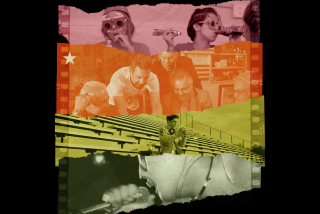Indian actress wants truth, not corn, in movies about her people
Sometimes, a big break sneaks up on you. Eleven years ago, Tenaya Torres was toiling at the lower end of the movie heap, getting small parts in films like “Pagans From Hell” and doing office work and diner jobs to keep afloat.
One afternoon, she got a telephone message to go for an interview about a commercial. “They wanted to know how soon I could get there,” recalls Torres. “I rushed to the interview wearing just what I had on--Levis, a denim shirt, a bandanna around my throat and some jewelry.”
Not only did she get the part, but the client wanted her to come back just as she was. That’s how America was introduced to the new, outdoorsy Mazola Margarine spokeswoman. It became the longest-running, most lucrative acting job the slim, exotic-looking actress with the torrent of black hair has ever had.
For the next eight years, Torres’ high cheekbones and doe eyes became synonymous with low-cholesterol, corn-derived goodness and with American Indian traditions.
It wasn’t exactly like winning an Academy Award, acknowledges Torres, who was born in New Mexico and now lives in both Walnut and Los Angeles (the city for business and Walnut for “grass, trees, flowers and all the other things they don’t have in L. A.”).
But the story is more than just another amusing piece of Hollywood trivia, insists the actress, who is three-quarters Apache. “When else could an American Indian turn on the tube and say, ‘I can identify with that person?’ ” she says. “I wasn’t portraying a drunken Indian. I was portraying a modern type of Native American.”
As a member of the City-County Native American Indian Commission, recently appointed by County Supervisor Pete Schabarum, Torres hopes to promote more positive images--and positive action.
She is in good company in Los Angeles. “Most people don’t know that there are more Native Americans in Los Angeles than anyplace else except the Navajo Reservation in New Mexico and Arizona.” (Actually, says Jack Stafford, director of the Southern California Indian Center, there is a larger concentration of Indians in Los Angeles and Orange counties than in any other comparable area of the country.)
Torres, who once viewed politics as “something foreign to me,” has gotten hooked on political causes. The depictions of Indians by the American film industry, for example, have become a special passion for her.
“Hollywood doesn’t deal with honesty and truth,” she says. “It deals with what makes a good scene.” The result has been a mixture of the demeaning and the well-meaning, she suggests.
“I don’t really know a single film that’s a true portrayal,” she says. “The one that I feel was the most honest was ‘One Flew Over The Cuckoo’s Nest.’ ” In that movie, actor Will Sampson portrayed a mountain-sized Indian mental patient, ultimately the sanest character in the story’s assortment of patients and professionals.
The only antidote to portrayals of screaming redskins who can’t hold their firewater is to get more Indians involved in movie-making, both in front of and behind the camera, Torres says. “One of the big problems is that Native Americans are always being written about by others,” she says. “It’s got to be done from our point of view now.”
Thus, she has been active in minority groups seeking better recognition in the film industry. Already, she sees a few glimmers of change. “There are two Latino films out there right now, ‘Born in East L. A.’ and ‘La Bamba,’ ” she said. “The studios must be in a state of shock seeing how successful they’ve been.”
Torres, who has had minor parts in movies such as “The Manitou” and “The Black Marble,” says she wants to see an Indian cultural center established in Los Angeles. “Drive down the street and you’ll see a Lithuanian center,” she says. “Everybody has a cultural center, a place to congregate. Native Americans are always at the bottom when it comes to receiving benefits.”
In the meantime, she keeps plugging away at her acting career, again waiting for that big break. “It can happen any time,” she says.
More to Read
Only good movies
Get the Indie Focus newsletter, Mark Olsen's weekly guide to the world of cinema.
You may occasionally receive promotional content from the Los Angeles Times.








